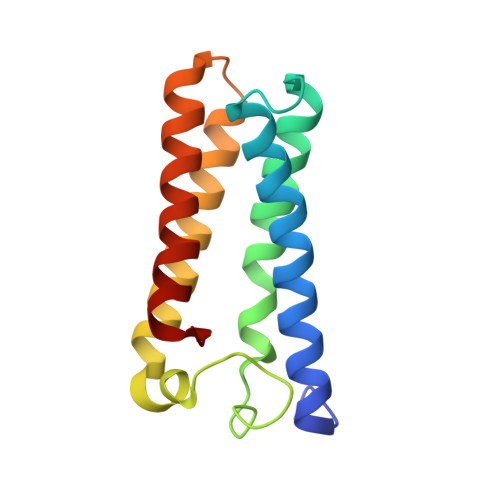Contribution of a surface salt bridge to the protein stability of deep-sea Shewanella benthica cytochrome c'.
Fujii, S., Sakaguchi, R., Oki, H., Kawahara, K., Ohkubo, T., Fujiyoshi, S., Sambongi, Y.(2023) J Struct Biol 215: 108031-108031
- PubMed: 37758155
- DOI: https://doi.org/10.1016/j.jsb.2023.108031
- Primary Citation of Related Structures:
8H28 - PubMed Abstract:
Two homologous cytochromes c', SBCP and SVCP, from deep-sea Shewanella benthica and Shewanella violacea respectively exhibit only nine surface amino acid substitutions, along with one at the N-terminus. Despite the small sequence difference, SBCP is thermally more stable than SVCP. Here, we examined the thermal stability of SBCP variants, each containing one of the nine substituted residues in SVCP, and found that the SBCP K87V variant was the most destabilized. We then determined the X-ray crystal structure of the SBCP K87V variant at a resolution of 2.1 Å. The variant retains a four-helix bundle structure similar to the wild-type, but notable differences are observed in the hydration structure around the mutation site. Instead of forming of the intrahelical salt bridge between Lys-87 and Asp-91 in the wild-type, a clathrate-like hydration around Val-87 through a hydrogen bond network with the nearby amino acid residues is observed. This network potentially enhances the ordering of surrounding water molecules, leading to an entropic destabilization of the protein. These results suggest that the unfavorable hydrophobic hydration environment around Val-87 and the inability to form the Asp-91-mediated salt bridge contribute to the observed difference in stability between SBCP and SVCP. These findings will be useful in future protein engineering for controlling protein stability through the manipulation of surface intrahelical salt bridges.
Organizational Affiliation:
Graduate School of Integrated Sciences for Life, Hiroshima University, Higashi-Hiroshima, Japan; Diamond Light Source Ltd., Harwell Science and Innovation Campus, Didcot, UK. Electronic address: sofuji@hiroshima-u.ac.jp.















